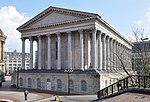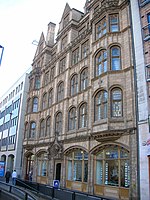Chamberlain Memorial
Grade II listed buildings in BirminghamMemorials to Joseph ChamberlainMonuments and memorials in Birmingham, West Midlands

The Chamberlain Memorial, also known as the Chamberlain Memorial Fountain, is a monument in Chamberlain Square, Birmingham, England, erected in 1880 to commemorate the public service of Joseph Chamberlain (1836–1914), Birmingham businessman, councillor, mayor, Member of Parliament, and statesman. An inauguration ceremony was held on 20 October 1880, when Chamberlain himself was present.
Excerpt from the Wikipedia article Chamberlain Memorial (License: CC BY-SA 3.0, Authors, Images).Chamberlain Memorial
Chamberlain Square, Birmingham Ladywood
Geographical coordinates (GPS) Address Nearby Places Show on map
Geographical coordinates (GPS)
| Latitude | Longitude |
|---|---|
| N 52.479952777778 ° | E -1.9041944444444 ° |
Address
Chamberlain Square
Chamberlain Square
Birmingham, Ladywood
England, United Kingdom
Open on Google Maps









